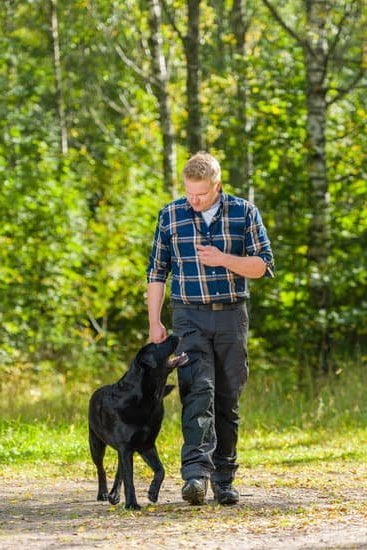Is your furry friend having trouble getting a good night’s sleep? Understanding how to train a dog to sleep is an essential part of ensuring their overall well-being. Dogs, like humans, require adequate rest for their physical and mental health. In this guide, we will explore the importance of sleep for dogs and look at the various factors that can affect their sleep patterns, including age, breed, and size.
Just like humans, dogs have individual sleep needs that can vary based on several factors. Puppies, adult dogs, and senior dogs all have different requirements when it comes to sleep duration and quality. Additionally, different breeds and sizes of dogs may have distinct sleeping patterns influenced by their energy levels and natural tendencies. By understanding these factors, you can tailor your approach to training your dog to sleep in a way that meets their specific needs.
Creating the perfect sleep environment for your dog is another crucial aspect of training them to sleep well. From choosing an appropriate bed to adjusting the temperature and lighting in their sleeping area, there are numerous ways to ensure that your dog has a comfortable and peaceful space where they can rest. By paying attention to these details, you can help set the stage for a more restful night’s sleep for your canine companion.
Creating the Perfect Sleep Environment
Creating a comfortable and peaceful sleep environment for your dog is essential for ensuring they get the rest they need. Choosing the right bed is crucial, as it should provide proper support and comfort based on your dog’s size, age, and any specific needs they may have. For example, older dogs or those with joint issues may benefit from orthopedic beds, while smaller breeds might prefer a cozy, cave-like bed for added security.
In addition to selecting the right bed, it’s important to consider the temperature and lighting of your dog’s sleep space. Dogs are sensitive to their surroundings, so keeping the room at a comfortable temperature can help promote better sleep. Similarly, adjusting the lighting in the room can signal to your dog when it’s time to rest. Dimming the lights in the evening can help create a calming atmosphere that cues your dog it’s time for sleep.
Another tip for creating the perfect sleep environment for your dog is to ensure their sleep space is free from distractions and any potential sources of stress or anxiety. This could mean placing their bed in a quiet area of the house away from noise or activity, using white noise machines to drown out sounds that could disturb their sleep, or providing them with familiar items such as blankets or toys that offer comfort and security.
| Creating a Perfect Sleep Environment | Tips |
|---|---|
| Choose the right bed | Selecting a bed based on size, age, and specific needs |
| Temperature and lighting | Keeping the room at a comfortable temperature; adjusting lighting for relaxation |
| Avoiding distractions | Placing bed away from noise; providing familiar items for comfort |
Establishing a Consistent Sleep Schedule
Understanding the Importance of a Regular Sleep Routine
Just like humans, dogs benefit from having a regular sleep schedule. Establishing consistent sleep patterns can help your dog feel more secure and reduce anxiety, leading to better overall health and behavior. Dogs thrive on routine, so having set bedtime and wake-up times can provide them with a sense of structure and stability in their daily lives.
Practical Steps for Setting a Sleep Schedule
To train your dog to sleep at specific times, it’s important to start by observing their natural sleep patterns. Take note of when your dog naturally relaxes and begins to wind down for the night. From there, you can gradually adjust their schedule to align with your own. Be sure to incorporate plenty of exercise and mental stimulation during the day to help your dog feel tired at the appropriate bedtime.
Using Positive Reinforcement for Sleep Training
Positive reinforcement techniques such as verbal praise, treats, or a favorite toy can be effective tools in training your dog to adhere to their sleep schedule. When your dog goes to bed at the designated time and remains in their sleeping area throughout the night, be sure to offer rewards and encouragement. Consistency is key in reinforcing this behavior, so be patient and persistent in providing positive reinforcement for good sleep habits.
These practical steps, combined with positive reinforcement techniques, can help train a dog to sleep at specific times and establish a consistent sleep routine that promotes overall well-being. By taking these proactive measures, you can create a comfortable and peaceful environment for your dog’s rest while strengthening your bond with them through positive training methods.
Positive Reinforcement Training
Principles of Positive Reinforcement Training
Positive reinforcement training involves rewarding your dog for displaying desirable behaviors, such as going to sleep in their designated area or staying there throughout the night. This could include offering treats, praise, or toys as a form of reward when your dog exhibits the desired behavior. By consistently rewarding good behavior, you are effectively encouraging your dog to repeat these actions in the future.
Implementing Positive Reinforcement Techniques for Sleep Training
When using positive reinforcement to train your dog to sleep through the night and stay in their designated sleep area, it’s important to be consistent and patient. Start by providing rewards when your dog goes to their bed at bedtime or remains there during the night.
Over time, gradually reduce the frequency of rewards as your dog becomes more accustomed to their sleeping routine. It’s also essential to avoid using punishment or negative reinforcement, as this can create anxiety and disrupt the sleep training process.
Additional Tips for Successful Sleep Training
In addition to using positive reinforcement techniques, there are other steps you can take to support successful sleep training for your dog. This includes incorporating daily exercise and mental stimulation into their routine, creating a comfortable sleep environment, and establishing a consistent sleep schedule. By combining these elements with positive reinforcement training, you can help your dog develop healthy sleeping habits and enjoy restful nights.
Addressing Sleep Disturbances
Separation anxiety is a common sleep disturbance in dogs, particularly when they are left alone at night. This condition can cause distress and disruptive behaviors, making it challenging for both the dog and their owner to get a good night’s sleep. However, there are several strategies that you can implement to address and prevent separation anxiety in your dog, allowing them to sleep peacefully through the night.
One effective way to manage separation anxiety in dogs is by gradually acclimating them to being alone. This can be done by leaving them alone for short periods of time and gradually increasing the duration as they become more comfortable with being on their own. It’s important to make these periods of solitude positive experiences for your dog by offering treats, toys, or other forms of enrichment to keep them engaged while you’re away.
Another strategy for addressing separation anxiety in dogs is to create a calming environment for them while you’re not at home. This may include playing soothing music or leaving comforting items such as blankets or clothing with your scent on them to provide a sense of security for your dog. Additionally, incorporating ample exercise and mental stimulation into their daily routine can help reduce anxiety and promote better sleep.
In cases where separation anxiety persists despite these efforts, seeking professional help from a veterinarian or certified dog trainer may be necessary. They can offer tailored guidance and potentially recommend behavioral training techniques or even medication to alleviate the symptoms of separation anxiety and improve your dog’s ability to sleep soundly through the night.
- Gradually acclimate your dog to being alone
- Create a calming environment with soothing music and comforting items
- Incorporate exercise and mental stimulation into their daily routine
- Seek professional help if needed
Exercise and Mental Stimulation
When it comes to ensuring that your dog gets a good night’s sleep, exercise and mental stimulation play a crucial role. Just like with humans, physical activity and mental engagement are key factors in promoting quality sleep for dogs. By providing your furry friend with ample opportunities for both, you can help them get the rest they need to stay healthy and happy.
Regular exercise not only helps to tire out your dog physically, but it also has a positive impact on their mental well-being. Taking your dog for daily walks, engaging in playtime, or participating in activities such as agility training can help reduce excess energy and anxiety, leading to better sleep at night.
In addition to physical activity, mental stimulation is equally important for promoting quality sleep in dogs. Engaging your dog in activities that challenge their mind, such as puzzle toys or obedience training, can help alleviate boredom and prevent disruptive behavior at bedtime. Mental stimulation can also contribute to reducing anxiety and stress levels, further enhancing your dog’s ability to relax and fall asleep peacefully.
| Activity | Impact |
|---|---|
| Daily walks | Reduction of excess energy and anxiety |
| Puzzle toys | Challenges the mind and prevents disruptive behavior at bedtime |
| Agility training | Physical exhaustion and mental engagement |
By incorporating both physical activity and mental stimulation into your dog’s daily routine, you can promote better sleep quality and overall well-being. This holistic approach to addressing your dog’s needs will not only benefit their sleep patterns but also contribute to a healthier and happier lifestyle.
Nutrition and Sleep
Just like humans, dogs’ diet and feeding times can have a significant impact on their sleep quality. By understanding the connection between nutrition and sleep, you can help create an environment that promotes better rest for your furry friend. Here are some key considerations for ensuring your dog’s diet supports healthy sleep patterns:
- Feeding Times: Establishing regular feeding times for your dog can help regulate their digestive system and promote a consistent sleep schedule. Aim to feed your dog at the same times each day, ideally in alignment with their natural circadian rhythm.
- Meal Content: The type of food you feed your dog can also influence their sleep quality. Ensure that their meals are high-quality, balanced, and provide the necessary nutrients for overall health. Avoid feeding them large or heavy meals right before bedtime to prevent discomfort and potential disturbances during the night.
In addition to meal content and timing, it’s important to consider how your dog’s diet may be impacting their energy levels and overall well-being. Ensuring that they receive adequate nutrition throughout the day can contribute to their ability to relax and rest peacefully at night.
Ultimately, paying attention to your dog’s dietary needs and establishing a consistent feeding routine can positively impact their sleep quality. If you have concerns about how your dog’s diet may be affecting their sleep patterns, consulting with a veterinarian or animal nutritionist can provide valuable insights on how to support better rest through nutrition.
By being mindful of these factors, you can take proactive steps to optimize your dog’s diet in a way that promotes healthy sleep habits, contributing to their overall well-being and quality of life.
Seeking Professional Help
In summary, training a dog to sleep involves understanding their sleep needs, creating a comfortable sleep environment, establishing a consistent sleep schedule, using positive reinforcement training, addressing sleep disturbances, providing exercise and mental stimulation, considering nutrition, and seeking professional help when needed. By taking a holistic approach to your dog’s sleep habits, you can promote better quality rest for your furry friend and ultimately enhance their overall well-being.
One of the most important aspects of training a dog to sleep is establishing a consistent sleep schedule. Dogs thrive on routine, so having set times for bedtime and wake-up can help regulate their internal clock and improve their ability to relax and rest.
Positive reinforcement training can also play a crucial role in encouraging your dog to sleep through the night and stay in their designated sleeping area. By rewarding desirable behavior with treats or praise, you can reinforce good sleeping habits in your dog.
However, it’s essential to recognize that some dogs may have persistent sleep issues that require professional intervention. If you’ve tried various strategies without success or notice concerning symptoms related to your dog’s sleep patterns, seeking assistance from a veterinarian or professional dog trainer is recommended.
These professionals can provide expert guidance on how to train a dog to sleep better by addressing underlying medical conditions or behavioral issues that may be affecting their rest. With the right support and resources, you can work towards helping your dog achieve restful and rejuvenating sleep.
Frequently Asked Questions
How Do I Get My Old Dog to Sleep Through the Night?
Getting an old dog to sleep through the night may require some adjustments. Make sure your dog gets enough exercise during the day and create a comfortable sleeping environment. Try not to disrupt their routine too much before bedtime.
How Do I Get My Dog to Sleep by Itself?
To get your dog to sleep by itself, start by helping it get used to sleeping in its own designated space. Provide a comfortable bed and soothing background noise, like a fan or soft music. Reinforce positive behavior with rewards.
How Do You Get an Overtired Dog to Sleep?
If your dog is overtired and having trouble falling asleep, try calming activities such as gentle petting or massage, giving them a warm bath, or playing relaxing music. Establishing a consistent bedtime routine can also help signal that it’s time for sleep.

Welcome to the blog! I am a professional dog trainer and have been working with dogs for many years. In this blog, I will be discussing various topics related to dog training, including tips, tricks, and advice. I hope you find this information helpful and informative. Thanks for reading!





